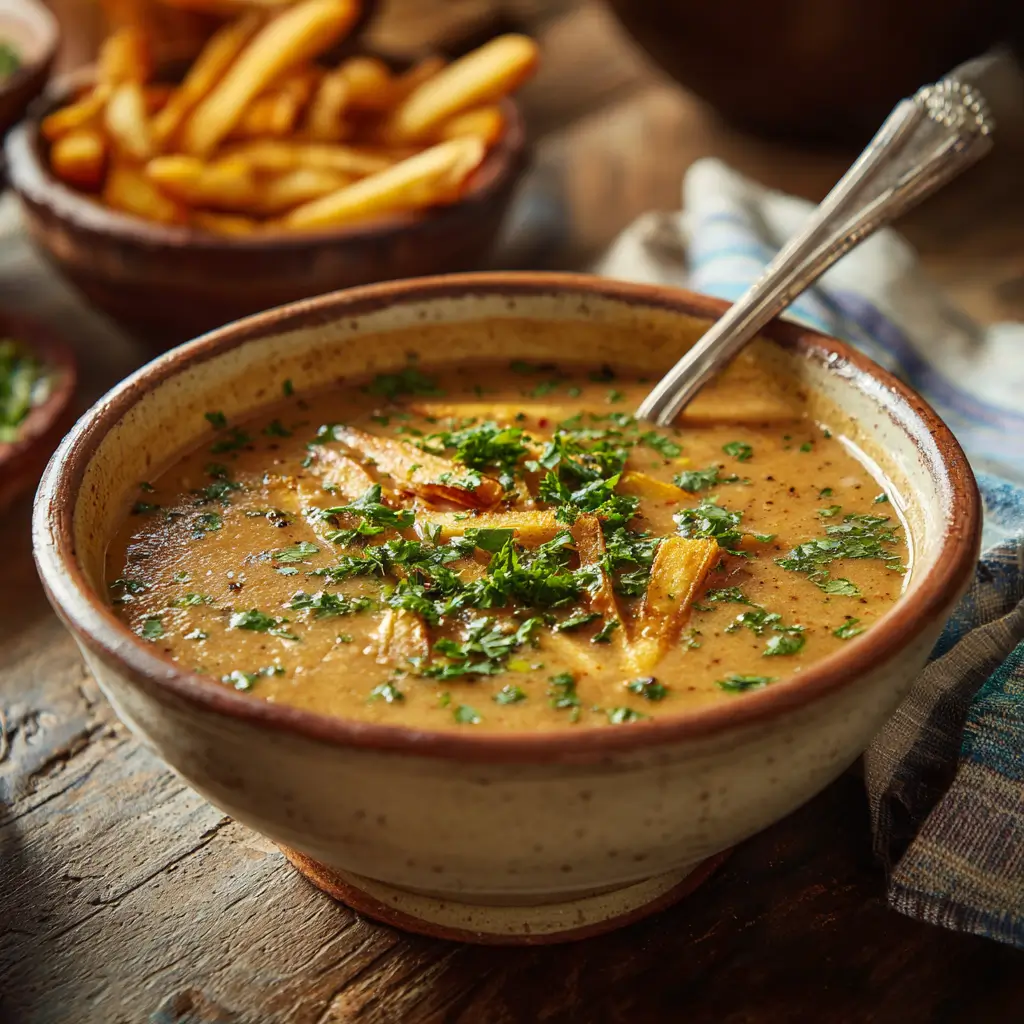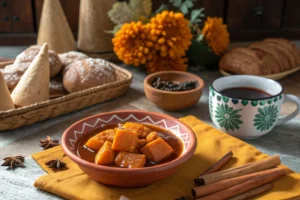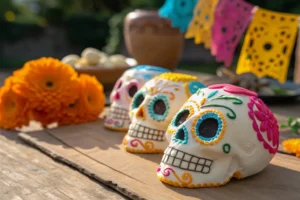There’s something undeniably comforting about a warm bowl of soup—especially when it’s rich, creamy, and packed with heritage. One of Bolivia’s best-kept culinary secrets, Tarija peanut soup, also known as sopa de maní, blends the earthy richness of peanuts with fresh vegetables, spices, and local love. But here’s the twist: this version is completely dairy-free—without compromising a hint of flavor.
Table of Contents
In this article, we’ll explore the cultural roots of this beloved dish from Tarija, show you how to make a dairy-free version, break down the nutritional benefits, and share tips on pairing, reheating, and even freezing it. Along the way, we’ll compare it to other famous peanut soups from around the world.
Don’t miss our dairy-free-chicken-pot-pie for another comfort classic with a modern twist.
Tarija Peanut Soup Recipe – Dairy-Free
- Prep Time: 10 minutes
- Cook Time: 30 minutes
- Total Time: 40 minutes
- Yield: 6 servings 1x
- Category: Soup
- Method: Stovetop
- Cuisine: Bolivian
- Diet: Gluten Free
Ingredients
1 cup raw peanuts (toasted, skinless)
1 onion, 2 garlic cloves, 2 potatoes, 1 carrot
1 tbsp tomato paste
1 tsp cumin, 1/2 tsp paprika
4 cups veggie broth, salt & pepper
Optional: parsley, fries, rice
Instructions
Instructions:
Toast and blend peanuts.
Sauté onion, garlic, and veggies.
Add tomato paste and broth.
Simmer till veggies are soft.
Stir in peanut paste. Simmer again.
Garnish and serve hot.
Notes
Vegan-friendly, gluten-free adaptable. Great for freezing.
Nutrition
- Serving Size: 1 bowl (approx. 1.5 cups)
- Calories: 325 kcal
- Sugar: 4 g
- Sodium: 420 mg
- Fat: 24 g
- Saturated Fat: 3.5 g
- Unsaturated Fat: 17 g
- Trans Fat: 0 g
- Carbohydrates: 20 g
- Fiber: 5 g
- Protein: 12 g
- Cholesterol: 0 mg
The Origins of Tarija Peanut Soup
The Culinary Roots of Tarija and Its Traditional Dishes
Nestled in Bolivia’s southern valleys, Tarija is a region known for its vineyards, warm climate, and rich gastronomic heritage. While empanadas and grilled meats often steal the spotlight, the heart of Tarija’s cuisine lies in its comforting soups—and none are as emblematic as sopa de maní, or peanut soup.
This dish has roots that stretch deep into the Andes, blending indigenous traditions with Spanish influences. Historically, peanuts were ground by hand with a mortar and pestle, then added to a stew of local vegetables, herbs, and occasionally beef or chicken. The creamy consistency and nutty aroma were signs that something nourishing—and delicious—was about to be served.
Over time, Tarija peanut soup became a staple in homes across the region, especially during celebrations and Sunday family meals. It’s often considered a bridge between generations, made with love and passed down like a family heirloom.
How Tarija Peanut Soup Reflects Bolivian Culture
Food in Bolivia is never just food—it’s a way to connect with the land and the people. In Tarija, peanut soup embodies this philosophy. Peanuts are more than just an ingredient; they represent abundance, health, and comfort.
Tarijeños often serve this dish in generous portions, garnished with shoestring potatoes, parsley, or even sliced boiled eggs. Every household has its own variation: some prefer it spicy, others add rice or pasta. But one thing’s for sure—it’s always made from scratch and with care.
Even today, street vendors and family-run restaurants continue the tradition, keeping sopa de maní alive in its most authentic form. Now, with the growing popularity of dairy-free and plant-based diets, it’s time for a modern twist on a classic dish—without losing its soul.
Why Choose a Dairy-Free Version of Tarija Peanut Soup
Understanding Dairy Sensitivities and Health Benefits
More people today are embracing dairy-free lifestyles—not just those with lactose intolerance or milk allergies. From skin issues to digestive problems, reducing dairy can often lead to noticeable health improvements. The good news? You don’t have to give up rich, creamy soups like Tarija peanut soup. By using plant-based alternatives, you get the best of both worlds: bold flavor and better digestion.
Many traditional recipes call for cream or milk to enhance the texture, but there’s a better way. Blending roasted peanuts with broth and vegetables creates a naturally creamy base that feels indulgent without being heavy. If you’re following a vegan, paleo, or whole-food diet, this version fits the bill perfectly.
Learn more about dairy-free cooking in our dairy-free cream of chicken soup guide.
Dairy-Free Doesn’t Mean Flavor-Free
Some people think going dairy-free means sacrificing taste. But the truth is, flavor doesn’t depend on dairy—it depends on balance. Roasted peanuts add deep umami, while ingredients like garlic, cumin, and paprika give Tarija peanut soup its signature aroma. You’ll get a silky texture and bold character that might even beat the original.
Dairy-free soups can be just as decadent when you know the right tricks. For instance, a spoonful of blended potato or soaked cashews can mimic that creamy mouthfeel. Even coconut milk—though optional—adds richness without overpowering the traditional peanut taste.
Discover great ideas like our dairy-free cream to elevate your plant-based dishes.
In fact, many of our readers have switched to this dairy-free version of sopa de maní and say it’s just as satisfying—if not more. With the right ingredients and process, you won’t miss dairy one bit.
Key Ingredients in Authentic Tarija Peanut Soup
Peanuts: The Star of the Show
No surprise here—the hero of this dish is the humble peanut. In Tarija, they traditionally use raw or lightly toasted peanuts, then grind them to a fine paste to achieve that velvety texture. This is what gives the soup its signature richness and nutty depth. Unlike peanut butter, using whole peanuts (with skin removed) gives you full control over the flavor, saltiness, and oiliness.
Peanuts are also a nutritional powerhouse. They’re packed with plant-based protein, healthy fats, and vital nutrients like magnesium, niacin, and folate. For those cutting back on meat or dairy, this soup becomes a hearty, filling option loaded with value.
For the dairy-free version, the peanuts pull double duty: they replace the creamy texture usually added with milk or cream and bring a bold, earthy character.
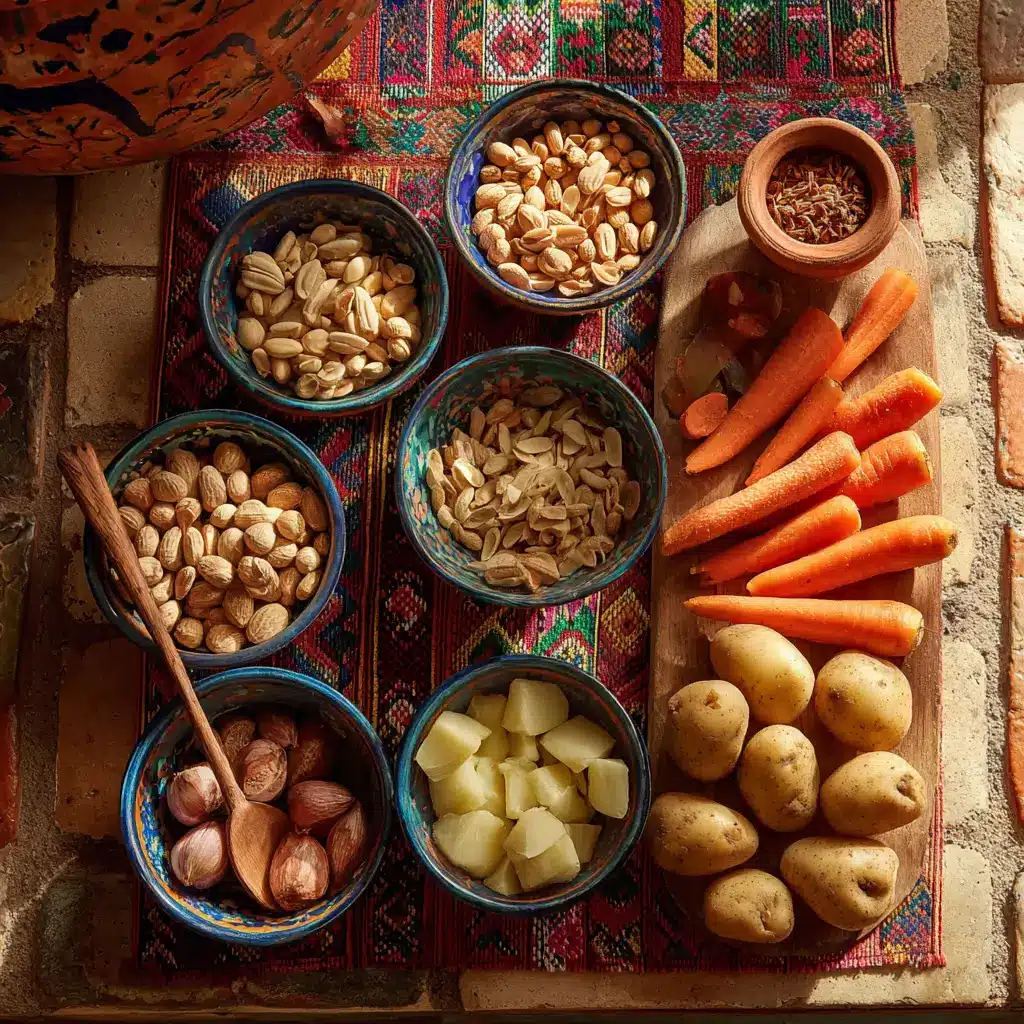
Don’t miss our detailed breakdown on plant-based protein sources in dairy-free protein shakes.
Supporting Ingredients: Vegetables, Spices, and Herbs
Beyond peanuts, the ingredients in Tarija peanut soup are simple, wholesome, and easy to find. Common add-ins include:
| Ingredient | Purpose in the Soup | Dairy-Free Alternative Needed? |
|---|---|---|
| Onion & Garlic | Aromatics that build the base | Naturally dairy-free |
| Carrots & Potatoes | Add sweetness and bulk | Naturally dairy-free |
| Tomato Paste | Enhances umami and color | Yes (choose dairy-free brand) |
| Cumin & Paprika | Signature Bolivian spices | Naturally dairy-free |
| Chicken or Veg Broth | Deepens flavor | Use veggie broth for vegan |
Fresh parsley or cilantro is often added before serving to brighten the dish. Some cooks add thin pasta, rice, or peas depending on the region or occasion.
Looking for inspiration? Try our dairy-free protein shakes for ideas on using peanuts beyond soup.
These simple, clean ingredients make this dish not just a taste of Bolivia—but also a versatile, allergy-friendly meal suitable for weeknight dinners, family gatherings, or a nourishing lunch.
How to Make Tarija Peanut Soup Dairy-Free
Step-by-Step Cooking Instructions with Pro Tips
Making a flavorful, dairy-free Tarija peanut soup at home isn’t hard—but it’s all about layering flavors the right way. Here’s a foolproof process to help you recreate this Bolivian classic in your kitchen:
Ingredients:
- 1 cup raw peanuts (toasted, skins removed)
- 1 medium onion, finely chopped
- 2 cloves garlic, minced
- 1 large carrot, diced
- 2 medium potatoes, peeled and chopped
- 1 tablespoon tomato paste
- 1 teaspoon ground cumin
- 1/2 teaspoon paprika (or smoked paprika)
- 4 cups vegetable broth (or chicken broth if not vegan)
- Salt and pepper to taste
- Fresh parsley or cilantro, for garnish
- Shoestring fries or cooked rice (optional topping)
Instructions:
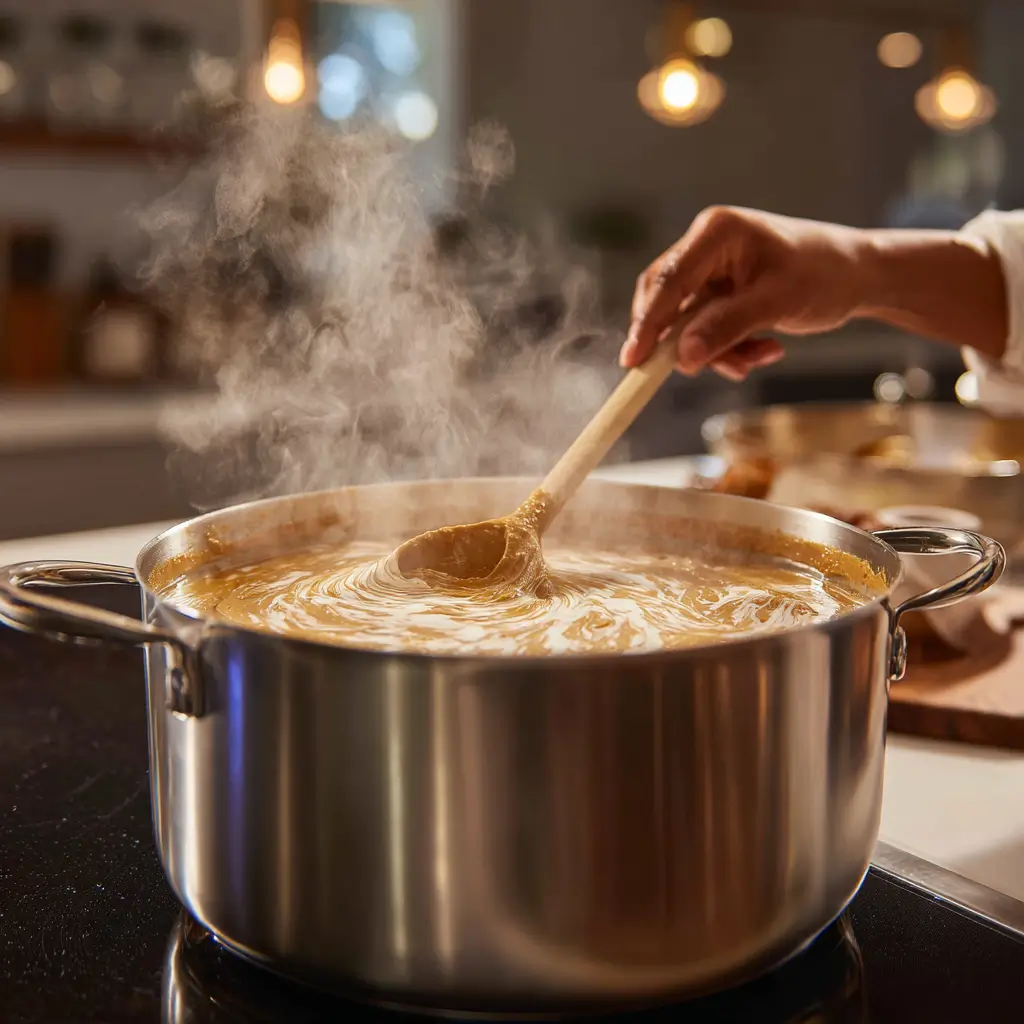
- Toast the peanuts in a dry pan over medium heat until golden. Let them cool, then blend into a thick paste using a splash of water.
- In a large soup pot, sauté onion and garlic in oil until translucent. Add the carrots, potatoes, cumin, and paprika. Stir for 2–3 minutes.
- Add the tomato paste and stir until it coats the vegetables evenly.
- Pour in the broth and bring to a gentle boil. Simmer for about 15 minutes or until the vegetables soften.
- Stir in the peanut paste, making sure it fully incorporates into the broth. Let it simmer another 10–15 minutes, stirring frequently.
- Adjust seasoning with salt and pepper. Serve hot, garnished with herbs and optional toppings like fries or rice.
Pro Tips:
- Blending half the soup can make it thicker without adding cream.
- Toasting the peanuts enhances depth—don’t skip this!
- If using peanut butter, make sure it’s unsweetened and no-stir.
Check out how we use similar tricks to enhance creaminess in our dairy-free cream guide.
Substitutions and Variations for Every Diet
One of the beauties of Tarija peanut soup is how adaptable it is. Whether you’re avoiding gluten, meat, or just want something plant-based, here’s how to tweak it:
| Dietary Need | Easy Swap |
|---|---|
| Vegan | Use veggie broth, skip chicken or eggs |
| Gluten-Free | Avoid pasta; use rice or potatoes instead |
| Nut-Free | Try sunflower seed butter, though flavor changes |
| Low Carb | Use cauliflower instead of potatoes |
| Protein Boost | Add quinoa or lentils into the soup base |
Learn more about dairy-safe alternatives in our is ghee dairy-free explainer.
This version honors the original Tarija spirit while opening the door for everyone—no dairy needed.
Nutritional Profile and Health Benefits
Protein, Fiber, and Healthy Fats in Peanuts
When people think of soup, they don’t always think nutrient-dense. But that’s where Tarija peanut soup stands out. Its core ingredient—peanuts—isn’t just about flavor. It’s a complete package of nutrition.
A single serving of peanuts (about 1 ounce) offers:
- 7g of protein
- 2.5g of fiber
- Healthy monounsaturated fats
- Vital nutrients like magnesium, zinc, niacin, and vitamin E
This makes peanut soup a smart choice for dairy-free diets or anyone needing a filling, plant-based meal. Peanuts support muscle repair, improve heart health, and even help regulate blood sugar levels due to their low glycemic index.
Paired with starchy vegetables like potatoes and carrots, this soup offers a balance of complex carbs, clean protein, and healthy fat, making it both satisfying and sustaining.
Discover great ideas like our dairy-free pancakes that also pack plant-based energy for the whole day.
How Tarija Peanut Soup Supports a Balanced Diet
The nutritional advantages of dairy-free Tarija peanut soup extend beyond peanuts:
- Vegetables provide antioxidants, vitamin C, and potassium
- Spices like cumin and paprika aid in digestion and reduce inflammation
- Broth-based soups help with hydration and electrolyte balance
- No dairy means fewer saturated fats and allergens
For those managing weight or cholesterol, replacing cream-based soups with nut-based versions like this one is a simple yet effective switch. Plus, it’s easy to modify for vegan, gluten-free, or diabetic-friendly diets.
Don’t miss our high-protein roundup in dairy-free protein shakes if you’re focused on clean energy.
And if you’re aiming for wellness without sacrificing flavor, this soup offers comfort with a clean conscience. It’s nourishing, grounding, and deeply satisfying—proof that traditional comfort food can be both indulgent and wholesome.
Serving Suggestions and Pairings
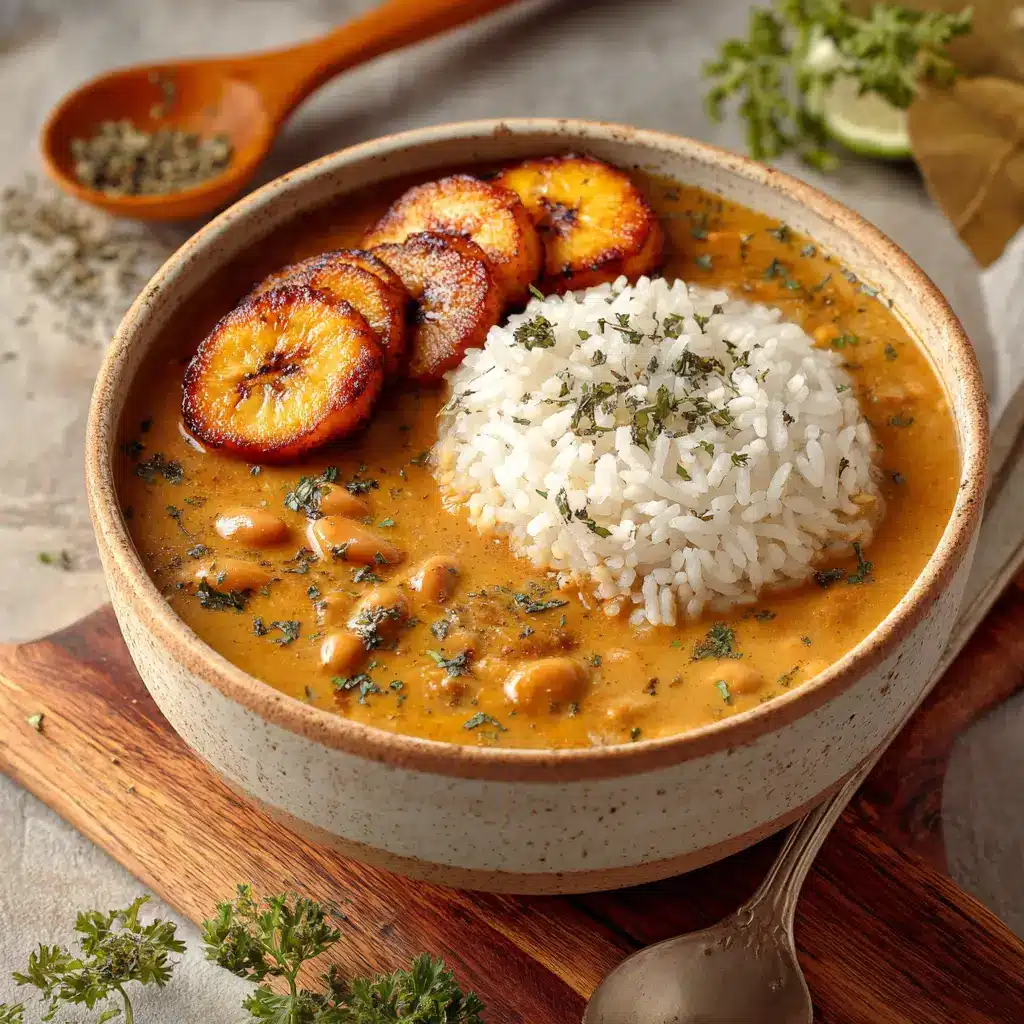
Traditional Bolivian Sides to Complement the Soup
In Tarija, peanut soup (sopa de maní) is more than a meal—it’s part of a full culinary experience. Bolivians often serve it with simple, rustic sides that soak up the rich flavors and add delightful contrast.
Here are traditional favorites:
| Side Dish | Why It Works with Peanut Soup |
|---|---|
| White Rice | Absorbs the broth and balances the richness |
| Shoestring Potatoes | Adds crunch and a salty counterbalance |
| Pan de Arroz | Gluten-free rice bread perfect for dipping |
| Ají Sauce | Brings heat and acidity |
| Hard-Boiled Eggs | Adds protein and creamy texture |
For a complete Bolivian-style meal, serve the soup hot in deep bowls, garnished with fries and fresh herbs, and include ajícito (a mild chili salsa) on the side for those who like it spicy.
Check out our guide to rich comfort foods like dairy-free chicken pot pie for more traditional favorites with a twist.
Modern Dairy-Free Pairings to Try Today
If you’re serving this dish outside of its traditional roots, it still pairs beautifully with contemporary, plant-based sides that match its creamy and savory profile. Try these modern dairy-free combinations:
- Grilled vegetable skewers – A smoky contrast that brings out the soup’s nuttiness
- Avocado toast with lime – Creamy, fresh, and layered with flavor
- Baked plantains – Sweet, soft, and naturally dairy-free
- Quinoa salad – For a protein-packed cold side
- Coconut-lime coleslaw – Cuts the richness with citrus and crunch
These pairings are great for weekday meals, weekend dinner parties, or meal-prepping in batches.
Learn more about layering flavors with dairy-free richness in our dairy-free cream walkthrough.
The balance of textures—from creamy soup to crispy or refreshing sides—elevates every spoonful. Whether you’re going traditional or fusion-style, there’s no wrong way to serve this Bolivian classic.
Storage, Freezing, and Reheating Tips
How Long Does Tarija Peanut Soup Last?
One of the many perks of dairy-free Tarija peanut soup is its durability. Without any dairy to spoil quickly, this soup can stay fresh longer while maintaining its flavor and texture.
Here’s what you can expect for shelf life:
| Storage Method | Duration |
|---|---|
| Refrigerator (sealed) | Up to 5 days |
| Freezer (airtight) | 2 to 3 months |
To store in the fridge, allow the soup to cool to room temperature before transferring it to a lidded glass container. This preserves flavor and avoids condensation that can lead to sogginess.
Pro tip: Store any toppings (like fries or parsley) separately and add them fresh when reheating.
Best Containers and Methods for Freezing
Freezing Tarija peanut soup works great because the base doesn’t separate like dairy-laden soups often do. Just make sure to follow these steps:
- Cool it completely before freezing—never freeze hot soup.
- Use BPA-free airtight containers or resealable freezer bags (leave 1 inch at the top for expansion).
- Label the containers with the date to track freshness.
- Freeze in individual portions for easy reheating later.
When it’s time to reheat:
- Thaw overnight in the fridge or in warm water for a quick defrost.
- Reheat on the stove over medium heat, stirring often.
- Add a splash of broth or water if it thickens too much.
Avoid the microwave if possible—it can overheat or unevenly warm the peanut paste. A gentle stovetop reheat keeps the flavor intact.
Don’t miss our cozy, freezer-friendly meals like dairy-free chicken pot pie for more comforting ideas.
With these storage hacks, you can make a big batch of dairy-free sopa de maní and enjoy it throughout the week—or month.
Variations of Tarija Peanut Soup Across Cultures
Comparing African Peanut Soup and Bolivian Peanut Soup
While Tarija peanut soup is a staple in southern Bolivia, it’s not the only peanut-based dish making waves across continents. In fact, peanut soups have a rich history in West African cuisine, particularly in countries like Ghana, Nigeria, and Senegal.
So how does the Bolivian version compare?
| Feature | Tarija Peanut Soup (Bolivia) | African Peanut Soup |
|---|---|---|
| Peanut Use | Toasted peanuts blended into paste | Peanut butter or groundnuts |
| Protein Base | Often chicken or vegetarian | Chicken, beef, or lamb |
| Spice Profile | Cumin, paprika, parsley | Ginger, garlic, chili, tomato |
| Texture | Silky, thinner, soup-like | Thick, stew-like consistency |
| Accompaniments | Fries, boiled egg, rice | Fufu, rice, plantains |
The key difference lies in texture and seasoning. Tarija’s version is more subtle in spice, usually milder and thinner, while African peanut soup often brings intense heat and a hearty stew-like body.
Both are delicious in their own right—and both highlight the incredible versatility of peanuts in global cooking.
Discover great ideas like our dairy-free cream that pair well with nut-based dishes from different cuisines.
Regional Ingredient Variations and Flavor Profiles
Even within Bolivia, sopa de maní changes based on region and season. In Tarija, it’s often a Sunday staple. In Cochabamba, versions include macaroni or hard-boiled eggs. Up north, the recipe may lean toward a thicker, stew-like base with added rice or corn.
Want to adapt the recipe to your taste or dietary needs? Here are popular variations:
- Spicy Version – Add red chili flakes or ají amarillo paste
- Vegan Version – Use vegetable broth, skip the egg, and bulk up with quinoa
- Low-Sodium Option – Use homemade, salt-free broth and unsalted peanuts
- Extra-Creamy – Blend the entire batch or add unsweetened almond milk
No matter how you adapt it, this dairy-free take on Tarija peanut soup stays grounded in tradition while letting you make it your own.
Learn more about crafting smooth, creamy textures in our dairy-free cream resource.
Frequently Asked Questions (FAQs)
What country is peanut soup from?
Peanut soup originates from multiple regions, but it’s most famously associated with West Africa—especially Ghana, Nigeria, and Senegal. In South America, Bolivia, particularly the Tarija region, also has a rich tradition of peanut-based soup known as sopa de maní. While ingredients and spices vary by region, the peanut remains a beloved staple across cultures.
Is peanut soup good for you?
Yes, peanut soup can be very healthy, especially when it’s dairy-free and made from whole, clean ingredients. Peanuts are rich in plant-based protein, healthy fats, and fiber, making them a satisfying and heart-healthy base. When combined with vegetables, herbs, and spices, the soup becomes a nutrient-dense meal that supports digestion, energy, and satiety.
For more health-forward ideas, explore our dairy-free protein shakes packed with similar plant-based goodness.
Is peanut soup good for diabetics?
In moderation, yes. Thanks to peanuts’ low glycemic index, they help control blood sugar levels. Plus, the fiber and protein in Tarija peanut soup slow digestion and glucose absorption. Just make sure to limit high-starch additions like potatoes or white rice if you’re watching your carb intake. Using sweet potatoes or quinoa instead is a great alternative.
What are the spices in African peanut soup?
African peanut soups typically include bold, warming spices like ginger, garlic, chili peppers, curry powder, and sometimes coriander or bay leaf. These differ from the milder Bolivian version, which often uses cumin, paprika, and parsley. Both profiles are rich and aromatic, highlighting how peanuts adapt beautifully to different spice blends.
Is vegan dairy-free?
Yes, vegan is always dairy-free. A vegan diet excludes all animal products, including milk, cheese, butter, and cream. So any vegan version of Tarija peanut soup is inherently dairy-free. However, not all dairy-free foods are vegan (e.g., dairy-free soups might still contain chicken broth), so it’s important to check the ingredients.
Looking for inspiration? Try our dairy-free protein shakes for energizing, vegan-friendly sips.
Conclusion
Whether you’re exploring Bolivian cuisine or looking for a cozy, nutrient-rich meal, Dairy-Free Tarija Peanut Soup delivers on every front. It’s a heartwarming blend of tradition and nutrition—rich, creamy, and full of flavor, without a drop of dairy.
From its cultural roots in Tarija to its modern, plant-based twist, this soup proves that you don’t need cream to achieve comfort in a bowl. Serve it with crispy fries or pair it with avocado toast. Freeze it for later or enjoy it fresh—however you choose to enjoy it, one thing’s for sure: this recipe deserves a spot in your weekly rotation.
Don’t miss our dairy-free comfort classics like dairy-free pancakes for more wholesome meals to pair with your plant-based lifestyle.
Follow us for more dairy-free and plant-based recipes:
Facebook: NYT Recipe on Facebook
Pinterest: NYT Recipe on Pinterest
